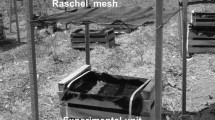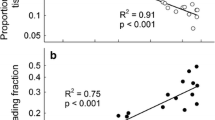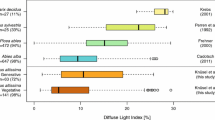Abstract
Bamboos native to temperate East Asian coniferous forests arrive with increasing frequency in the United States as horticultural imports, and some are becoming naturalized locally. Given the strong floristic and physiognomic similarities between East Asian and western North American coniferous forests, we asked whether these introduced bamboos could tolerate the varied light regimes within coniferous forests in their new range. Seven temperate Asian bamboos and one North American bamboo (Arundinaria gigantea) were grown within shade structures in an experimental garden; these structures reduced ambient light to three light levels (50, 70, 90 % shade) that occur routinely within coniferous forests in the Pacific Northwest. Species’ responses under these light levels were measured by their light response curves to photosynthesis, resource allocation to light or carbon harvesting centers inferred by CO2 response curves, and shifts amongst forms of leaf Chlorophyll. Bashania fargesii has lower chlorophyll content and photosynthetic rates under high shade (90 %) relative to other Asian species and to B. fargesii grown in 50 and 70 % shade. Bashania fargesii, Sasa kurilensis and A. gigantea also displayed lower photosynthetic rates under 90 % shade compared to plants grown in 50 and 70 % shade and lower electron transport capacity under 70 and 90 % shade compared to plants grown in 50 % shade. In contrast, Pleioblastus chino, Pleioblastus distichus, Pseudosasa japonica, Sasa palmata and Sasaella ramosa display strong tolerance of low light. Our results indicate these five Asian bamboos (and others yet to be introduced) could skirt a major environmental barrier to new species establishment in these North American forests. Measuring a species’ light response curve offers a reliable, rapid means to assess an immigrant species’ potential to tolerate forests’ varied light regimes.



Similar content being viewed by others
References
Anderson JM, Andersson B (1988) The dynamic photosynthetic membrane and regulation of solar energy conversion. Trends Biochem Sci 13:351–355
Andersson F (2005) Coniferous forests. Elsevier, Amsterdam
Bailey S, Walters RG, Jansson S, Horton P (2001) Acclimation of Arabidopsis thaliana to the light environment: the existence of separate low light and high light responses. Planta 213:794–801
Bauer J, Flory SL (2011) Suppression of the woodland herb Senna hebecarpa by the invasive grass Microstegium vimineum. Am Midl Nat 165:105–115
Bazzaz FA (1979) The physiological ecology of succession. Annu Rev Ecol Syst 10:351–371
Bazzaz FA, Carlson RW (1982) Photosynthetic acclimation to variability in the light environment of early and late successional plants. Oecologia 54:313–316
Berry J, Björkman O (1980) Photosynthetic response and adaptation to temperature in higher plants. Annu Rev Plant Physiol 31:491–543
Boardman NK (1977) Comparative photosynthesis of sun and shade plants. Annu Rev Plant Phys 28:355–377
Bryant G (1998) Botanica. D. Bateman, North Shore City
Chazdon RL, Pearcy RW (1991) The Importance of sunflecks for forest understory plants. Bioscience 41:760–766
Chinese Academy of Sciences KI of E (1994) Vegetation ecological landscapes of Yunnan. Kunming Institute of botany. China Forestry Publishing House, Beijing
Connell JH, Slatyer RO (1977) Mechanisms of succession in natural communities and their role in community stability and organization. Am Nat 111:1119–1144
D’Antonio CM, Vitousek PM (1992) Biological invasionvs by exotic grasses, the grass/fire cycle, and global change. Annu Rev Ecol Syst 23:63–87
Daehler CC, Denslow JS, Ansari SA, Kuo HC (2004) A risk-assessment system for screening out invasive pest plants from Hawaii and other Pacific Islands. Cons Biol 18:360–368
Daubenmire R (1970) Steppe vegetation of Washington. Washington agricultural experiment station technical bulletin 62. Washington State University Cooperative Extension, Pullman
Daubenmire R (1978) Plant Geography: with special reference to North America. Academic Press, New York
Daubenmire R, Daubenmire JB (1968) Forest vegetation of Eastern Washington and Northern Idaho. Washington agricultural experiment station technical bulletin 60. Washington State University Cooperative Extension, Pullman
Farquhar GD, von Caemmerer S (1982) Modeling of photosynthetic response to environmental conditions. Springer, New York
Flory SL, Clay K (2010) Non-native grass invasion suppresses forest succession. Oecologia 164:1029–1038
Franklin JF, Dyrness CT (1988) Natural vegetation of Oregon and Washington. Oregon State University Press, Corvallis
Gibson DJ, Spyreas G, Benedict J (2002) Life history of Microstegium vimineum (Poaceae), an invasive grass in Illinois. J Torrey Bot Soc 129:207–219
Gordon DR, Onderdonk DA, Fox AM, Stocker RK (2008a) Consistent accuracy of the Australian weed risk assessment system across varied geographies. Divers Distrib 14:234–242
Gordon DR, Onderdonk DA, Fox AM, Stocker RK, Gantz C (2008b) Predicting invasive plants in Florida using the Australian Weed Risk Assessment. Invasive Plant Sci Manag 1:178–195
Goto Y (2004) Early post-fire vegetation regeneration in Larix kaempferi artificial forests with an undergrowth of Sasa senanensis. Ecol Res 19:311–321
Guisan A, Zimmerman NE (2000) Predictive habitat distribution models in ecology. Ecol Model 135:147–186
Holdredge C, Bertness MD (2011) Litter legacy increases the competitive advantage of invasive Phragmites australis in New England wetlands. Biol Invasions 13:423–433
Holdridge LR (1967) Life zone ecology. Tropical Science Center, San Jose
Holm LG, Doll J, Holm E, Pancho JV, Herberger J (1997) World weeds: natural histories and distribution. Wiley, New York
Horton JL, Fortner R, Goklany M (2010) Photosynthetic characteristics of the C4 invasive exotic grass Miscanthus sinensis growing along gradients of light intensity in the Southeastern United States. Castanea 75:52–66
Hunt DM, Zaremba RE (1992) The northeastward spread of Microstegium vimineum (Poaceae) into New York and adjacent states. Rhodora 94:167–170
Ito H, Hino T (2004) Effects of deer, mice and dwarf bamboo on the emergence, survival and growth of Abies homolepis (Piceaceae) seedlings. Ecol Res 19:217–223
Janzen DH (1976) Why bamboos wait so long to flower. Annu Rev Ecol Syst 7:347–391
Judziewicz EJ, Clark LG, Londoño X, Stern MJ (1999) American bamboos. Smithsonian Books, Washington
Kayama M, Nomura K, Sugishita Y, Satoh F, Sasa K, Koike T (2000) Growth of dwarf bamboo community grown at cold and very windy adjacent sites in northern most Japan as affected by snow depth. J Bamboo 17:20–26
Kingdon-Ward F (1924) The romance of plant hunting. Edward Arnold and Co., London
Kubota K, Kubo H, Shimatani K (2007) Spatial pattern dynamics over 10 years in a conifer/broadleaved forest, northern Japan. Plant Ecol 190:143–147
Lambers H, Chapin FS 3rd, Pons TL (2006) Plant physiological ecology. Springer, Berlin
Lancaster R (1989) Plantsman’s paradise: travels in China. Antique Collector’s Club, Suffolk
Leiffers VJ, Stadt KJ (1994) Growth of understory Picea glauca, Calamagrostis canadensis, and Epilobium angustifolium in relation to overstory light transmission. Can J Forest Res 24:1193–1198
Leverenz JW (1987) Chlorophyll content and the light response curve of shade-adapted conifer needles. Physiol Plantarum 71:20–29
Long SP, Bernacchi CJ (2003) Gas exchange measurements, what can they tell us about the underlying limitations to photosynthesis? Procedures and sources of error. J Exp Bot 54:2393–2401
Mack RN (2005) Predicting the identity of plant invaders: future contributions from horticulture. HortScience 40:1168–1174
Mack RN (2011) Cheatgrass (Bromus tectorum L.). In Simberloff D, Rejmánek M (eds) Encyclopedia of Invasive Introduced Species. University of California Press, Berkeley, pp 108–113
Mack RN, Foster SK (2009) Eradicating plant invaders: combining ecologically based tactics and broad-sense strategy. In: Inderjit (ed) Management of Invasive Weeds. Springer, Heidelberg, pp 35–60
Mack RN, Simberloff D, Lonsdale WM, Evans H, Clout M, Bazzaz FA (2000) Biotic invasions: causes, epidemiology, global consequences, and control. Ecol Appl 10:689–710
Man R, Kayahara GJ, Rice JA, MacDonald GB (2008) Eleven-year responses of a boreal mixedwood stand to partial harvesting: light, vegetation, and regeneration dynamics. For Ecol Manag 255:697–706
March RH, Clark LG (2010) Sun-shade variation in bamboo (Poaceae: Bambusoideae) leaves. Telopea 13:93–104
Martin PH, Canham CD, Marks PL (2009) Why forests appear resistant to exotic plant invasions: intentional introductions, stand dynamics, and the role of shade tolerance. Front Ecol Environ 7:142–149
McClure FA (1966) The bamboos: a fresh perspective. Harvard University Press, Cambridge
Minton MS, Mack RN (2010) Naturalization of plant populations: the role of cultivation and population size and density. Oecologia 164:399–409
National Research Council (2002) Predicting invasions of nonindigenous plants and plant pests. Committee on the scientific basis for predicting the invasive potential of nonindigenous plants and plant pests in the United States. The National Academies Press, Washington
Numata M (1960) Progressive and retrogressive gradient of grassland vegetation measured by degree of succession—ecological judgment of grassland condition and trend IV. Plant Ecol 19:96–127
Numata M (1979) The ecology of grasslands and bamboolands in the world. The Hague, Amsterdam
Ohrnberger D (1999) The bamboos of the world: annotated nomenclature and literature of the species and the higher and lower taxa. Elsevier, Amsterdam
Petersen TD (1988) Effects of interference from Calamagrostis rubescens on size distributions in stands of Pinus ponderosa. J Appl Ecol 25:265–272
Peterson PM, Terrell EE, Uebel EC, Davis CA, Scholz H, Soreng RJ (1999) Oplismenus hirtellus subspecies undulatifolius, a new record for North America. Castanea 64:201–202
Pheloung PC, Williams PA, Halloy SR (1999) A weed risk assessment model for use as a biosecurity tool evaluating plant introductions. J Environ Manag 57:239–251
Platt SG, Brantley CG (1997) Canebrakes: an ecological and historical perspective. Castanea 62:8–21
Potvin C, Lechowicz MJ, Tardif S (1990) The statistical analysis of ecophysiological response curves obtained from experiments involving repeated measures. Ecology 71:1389–1400
Powelson RA, Lieffers VJ (1992) Effect of light and nutrients on biomass allocation in Calamagrostis canadensis. Ecography 15:31–36
Qian H, Ricklefs RE (2005) Beta diversity of angiosperms in temperate floras of eastern Asia and eastern North America. Ecol Lett 8:15–22
Ralph PJ, Gademann R (2005) Rapid light curves: a powerful tool to assess photosynthetic activity. Aquat Bot 82:222–237
Ratnam J, Bond WJ, Fensham RJ, Hoffmann WA, Archibald S, Lehmann CER, Anderson MT, Higgins SI, Sankaran M (2011) When is a “forest” a savannah, and why does it matter? Glob Ecol Biogeogr 20:653–660
Renger T, Madjet ME, Knorr A, Müh F (2011) How the molecular structure determines the flow of excitation energy in plant light-harvesting complex II. J Plant Physiol 168:1497–1509
Saitoh T, Seiwa K, Nishiwaki A (2002) Importance of physiological integration of dwarf bamboo to persistence in forest understory: a field experiment. J Ecol 90:78–85
Sax DF, Stachowicz JJ, Gaines SD (2005) Species invasions: insights into ecology evolution and biogeography. Sinauer Associates, Sunderland
Sharkey TD, Bernacchi CJ, Farquhar GD, Singaas EL (2007) Fitting photosynthetic carbon dioxide response curves for C3 leaves. Plant, Cell Environ 30:1035–1040
Simberloff D (2003) How much information on population biology is needed to manage introduced species? Cons Biol 17:83–92
Snow AA, Andow DA, Gepts P, Hallerman EM, Power A, Tiedje JM, Wolfen-barger LL (2005) Genetically engineered organisms and the environment: current status and recommendations. Ecol Appl 15:377–404
Soderstrom TR, Calderón CE (1979) A commentary on the bamboos (Poaceae: Bambusoideae). Biotropica 11:161–172
Suyama Y, Obayashi K, Hayashi I (2000) Clonal structure in a dwarf bamboo (Sasa senanensis) population inferred from amplified fragment length polymorphism (AFLP) fingerprints. Mol Ecol 9:901–906
Suzaki T, Kume A, Ino Y (2005) Effects of slope and canopy trees on light conditions and biomass of dwarf bamboo under a coppice canopy. J For Res 10:151–156
Taylor AH, Jinyan H, ShiQiang Z (2004) Canopy tree development and undergrowth bamboo dynamics in old-growth Abies-Betula forests in southwestern China: a 12-year study. For Ecol Manag 200:347–360
United States Department of Agriculture, Animal and Plant Health Inspection Service (2010) 319.37 Prohibitions and restrictions on importation; disposal and articles refused importation
Walter H (1985) Vegetation of the earth and ecological systems of the geo-biosphere. Spring-Verlag, Berlin
Wilson EH (1986) A naturalist in Western China. Cadogan, London
Wintermans JFGM, De Mots A (1965) Spectrophotometric characteristics of chlorophylls a and b and their phenophytins in ethanol. Biochim Biophys Acta 109:448–453
Woodward FI, Lomas MR, Kelly CK (2004) Global climate and the distribution of plant biomes. Philos Trans Royal Soc B 358:1465–1476
Wu Q (1999) Wild flowers of Yunnan in China. Kunming institute of botany. China Forestry Publishing House, Beijing
Zheng H, Wu Y, Ding Y, Binion D, Fu W, Reardon R (2004) Invasive plants established in the United States that are found in Asia and their associated natural enemies, Vol 1. US Dept. of agriculture, forest service. Forest Health Technology Enterprise Team, Washington
Zheng H, Wu Y, Ding Y, Binion D, Fu W, Reardon R (2005) Invasive plants established in the United States that are found in Asia and their associated natural enemies, Vol 2. US Dept. of agriculture, forest service. Forest Health Technology Enterprise Team, Washington
Acknowledgments
We thank three anonymous reviewers for their insightful and helpful remarks. We thank several people for their invaluable assistance. The project was primarily funded by a contract from USDA-APHIS with the invaluable assistance of A. Tasker. We thank J. Bishop for the use of a LI-6400 gas exchange system during four field seasons. C. Cody, J. Ringwood and others aided with splitting rhizomes and plant care during winter. T. Almquist and B. Connolly assisted with erecting shade structures. L. Clark gave excellent insight into bamboo-specific morphology. G. E. Edwards and A. Cousins gave invaluable advice regarding interpreting physiological responses.
Author information
Authors and Affiliations
Corresponding author
Electronic supplementary material
Below is the link to the electronic supplementary material.
10530_2013_434_MOESM1_ESM.tiff
Figure S1 Daily profiles of PAR in incoming radiation (no shade cloth) and under 50 %, 70 % and 90 % shade on 15 May and 15 July, 2007-2010 (n = 12). Plants’ light response measurements were taken from 1000 to 1800 h (shaded area). Supplementary material 1 (TIFF 1521 kb)
10530_2013_434_MOESM2_ESM.tiff
Table S1 Mean Chlorophyll content (mg cm−2) under different shade levels ± SE for leaves of 8 bamboo species. All species, except B. fargesii, displayed no shifts (ANOVA, P > 0.05) in Chla, Chlb, Chla:b, or total Chl. In contrast, total Chl was lowest for B. fargesii under 90 % shade (Tukey’s HSD, P = 0.047). Supplementary material 2 (TIFF 1521 kb)
Rights and permissions
About this article
Cite this article
Smith, M.C., Mack, R.N. Shade tolerance of temperate Asian bamboos: a harbinger of their naturalization in Pacific Northwest coniferous forests?. Biol Invasions 15, 2081–2093 (2013). https://doi.org/10.1007/s10530-013-0434-y
Received:
Accepted:
Published:
Issue Date:
DOI: https://doi.org/10.1007/s10530-013-0434-y




